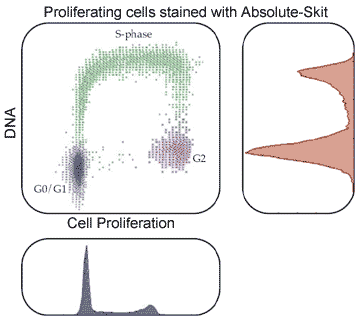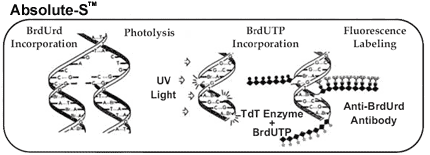ABSOLUTE-S™ enables the unequivocal identification of proliferating cells. It does so in a way that preserves other cellular constituents, allowing them to be simultaneously labeled, if desired. This is accomplished by combining
three key features:
- BrdU uptake by proliferating cells (incorporated into the newly synthesized DNA);
- Use of the patented SBIP (Strand Breaks Induced by Photolysis) methodology to make the incorporated BrdU accessible for labeling, with no acid, heat or DNase treatment (this is what preserves the other cellular constituents);
- Labeling with the PRB-1 anti-BrdU monoclonal antibody, clearly established as the antibody of choice for this application.
 ABSOLUTE-S is typically used to measure both cell proliferation and cellular DNA content/cell cycle position. The latter measurement is made by labeling cellular DNA with propidium iodide and then measuring the DNA associated fluorescence. This step may be omitted if it is desired to label/measure other surface or intracellular antigens. The kit contains instructions and all of the reagents needed to perform each of the steps in the assay. Control cells are also included to eliminate any guesswork in interpreting the results. ABSOLUTE-S is typically used to measure both cell proliferation and cellular DNA content/cell cycle position. The latter measurement is made by labeling cellular DNA with propidium iodide and then measuring the DNA associated fluorescence. This step may be omitted if it is desired to label/measure other surface or intracellular antigens. The kit contains instructions and all of the reagents needed to perform each of the steps in the assay. Control cells are also included to eliminate any guesswork in interpreting the results.
[Note: Additional control cells or other kit components may be purchased separately, if needed. Use the ID ASPC11 for the Reaction Control and ASNC12 for the Photolysis Control. Ask for details on other kit components.]
Life and Death combines the TUNEL and SBIP methodologies in a single kit. Selective DNA strand break induction by photolysis (SBIP) at sites that contain incorporated bromodeoxyuridine (BrdU) nucleotides is well established as a means of analyzing DNA replication and detecting proliferating cells. The presence of numerous in-situ DNA strand breaks is also an inherent feature of apoptotic cells and these breaks are best detected using the TUNEL (Terminal deoxynucleotide transferase dUTP Nick End Labeling) technique.

Combining these methodologies in a single kit minimizes the labor involved in making these measurements and also eliminates any guesswork in interpreting the results. Since homeostasis of any cell system requires balanced rates of cell proliferation and death (death predominantly by apoptosis), the life and death assay allows the study of this state or its alterations (e.g., tumor growth and/or response to chemotherapy). The best approach is to measure
proliferative and apoptotic indices simultaneously in the same cell sample, precisely what is enabled by the Life and Death Assay Kit.
|